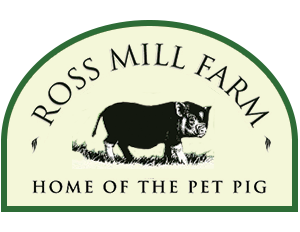If you search Pig Placement Network’s online database, you’ll find that each pig’s profile lists him or her
as “Indoor” or “Outdoor.” These terms should not be taken as black and white, though. An outdoor pig
still needs a cozy shelter with bedding, whether that is a barn stall, shed, or garage. And no pig should
be 100% indoors; all need plenty of time outside, with room to wander and explore. An apartment or
house with more than a few stairs to the yard are inappropriate environments, as they will limit her
(safe) access to this basic need. There are a number of reasons that time in the great outdoors is
essential to a pig’s health and happiness (and probably to your sanity as well!).
1. Mental Stimulation: Pigs are curious and intelligent animals who need mental stimulation and
the ability to engage in natural behaviors such as foraging, rooting, and wallowing. If she never
leaves the house, boredom can quickly set in; as a result, behavior issues including aggression,
destructiveness, and housetraining lapses may occur. She may also become depressed and
withdrawn. Many pigs are rehomed for these reasons, when increased outside time and space
may be all that’s needed to resolve the issue and improve her quality of life.
2. Exercise: Pigs are not generally active the way a dog is; they aren’t interested in playing fetch or
going on hikes. Especially once she reaches maturity, your pig will likely spend most of her time
outside meandering or even lounging in the sun. But she does need to get some exercise, even if
it’s just exploring or walking around as she grazes. Exercise has many of the same benefits for
pigs as it does for any of us: enrichment, weight management, strength and stamina, digestive
regularity, and overall health. Young pigs in particular will get the “zoomies,” and there are few
things cuter than a pig tearing around the yard in laps of pure joy!
3. Rooting: Rooting is a natural and instinctive behavior in which a pig uses her nose to turn the
soil and access roots, grubs, and other morsels below the surface. It is also an important sensory
experience in which she explores her environment through smell, touch, and taste. Not all pigs
will root to the same degree; some only root a little at specific times of year, while others are
regular tillers. But if she lacks access to a place to root, your pig may get frustrated and start
digging up your carpet or even root on you to the point of bruising. If you are concerned about
damage to your landscaping, there are ways to minimize the impact of this behavior; see this
article for more information.
4. Grazing: Pigs are natural grazers and foragers, and access to edible grasses and other plants is
important for multiple reasons. The bulk of grass will help her feel full and manage her weight.
The fiber and moisture keep her digestive system moving and prevent constipation. Ingesting
grass (as well as soil and other little goodies she might find) supports a healthy immune system
and provides valuable nutrition.
You do need to make sure that your yard is safe for grazing. Fertilizers, pest treatments, and
other chemicals can be toxic to pigs, so keep your yard chemical-free. Even some “natural” lawn
treatments that may be described as “pet-safe” can affect pigs (especially since they are actively
consuming the grass), so discuss any products with your pig-savvy vet before use and err on the
side of caution. Also ensure that your pig doesn’t have access to toxic plants in your garden or
yard.
5. Nutrition: Like us, pigs need time in the sunshine to produce vitamin D, which, in turn, assists in
the absorption of calcium and phosphorous. They also access beneficial bacteria and essential
nutrients in the soil. As mentioned previously, grazing provides important vitamins and minerals,
and is a good supplement to a balanced mini pig pelleted feed.
We all benefit from time in nature, but for pigs it is vital to their wellbeing. The larger, more natural, and
more interactive a pig’s space is, the better. Incorporating wooded or brushy areas as well as a diverse
yard to graze is ideal, as it keeps things interesting. But your pig will benefit from time outdoors even if
it’s just a suburban lawn.
Make sure your pig has a safe enclosure for times when she is outside unsupervised, one that will keep
her in and rogue dogs out. 16’x16’ is a bare minimum pen size, but we recommend giving her as much space as possible or allowing her out of her pen when you are there to watch her.
Some people harness-train their pigs and supplement their yard time with walks, but they still need time to just be pigs.
Also remember the 3 S’s of outside time; make sure your pig has access to shade and shelter from the
elements, and apply sunscreen to protect her from sunburn and skin cancer.
One of the best ways to support your pig’s wellbeing is time outdoors engaging in her natural behaviors,
stimulated and enriched through exploration of her environment. It will bring her joy and contentment,
and you will feel the same as you share your life with a happy and well-adjusted pig.


